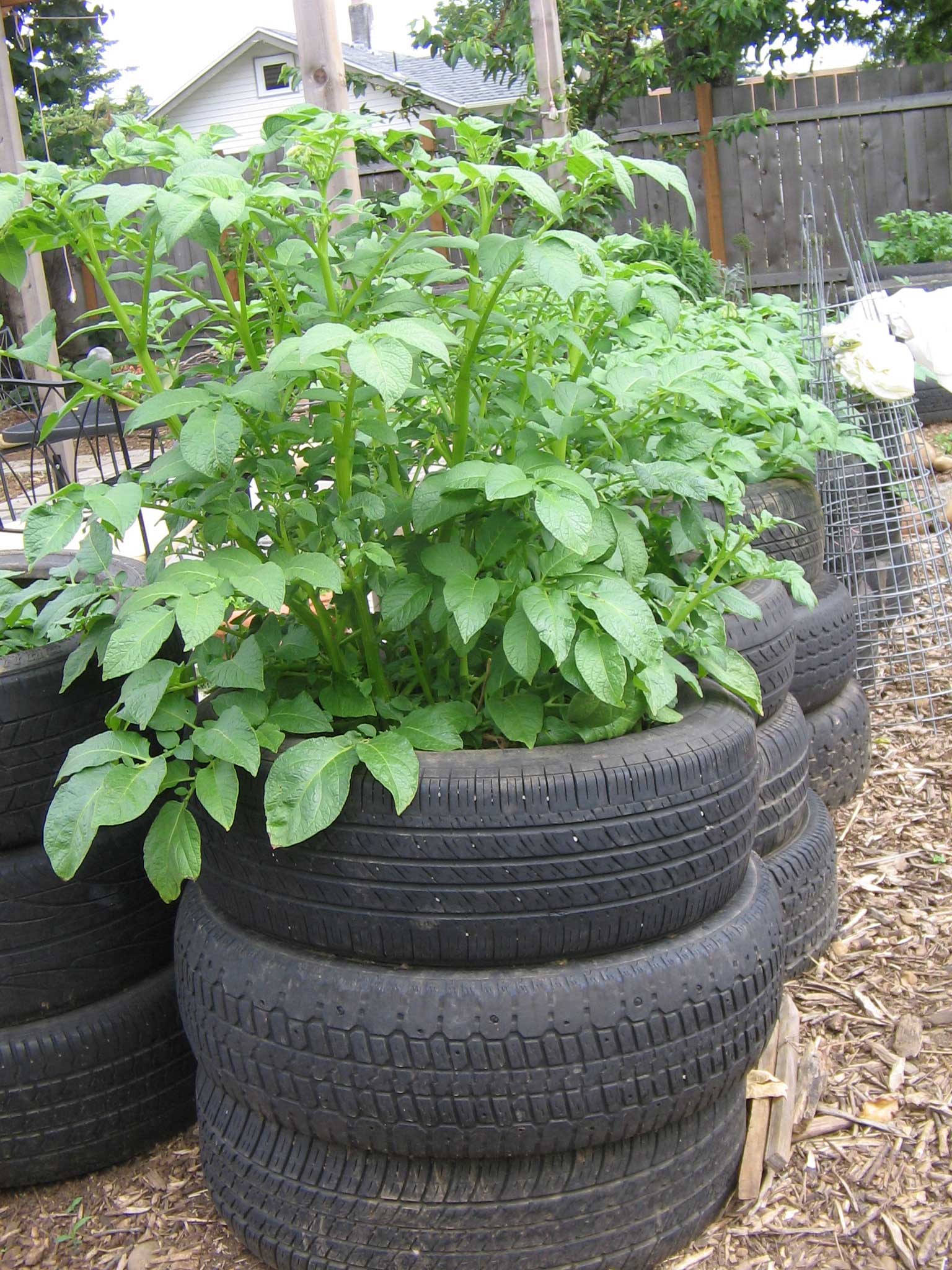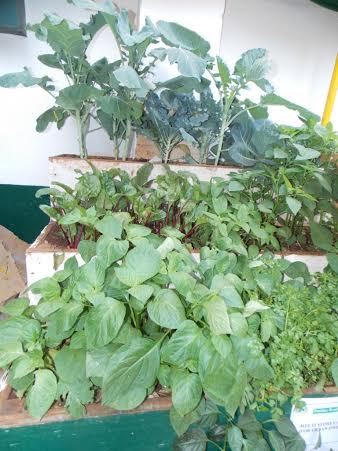Written by Bob Koigi for Farmbizafrica
Bereta Wahinya a retired teacher in the low income Kawangware area of Nairobi has never known food woes despite the erratic supply and prices of most staple produce in Nairobi occasioned by an under production by rural farmers who supply to Nairobi.
In her small land, facing her house, are one hundred old tires that sits uniformly and neatly on each other and which she uses to grow tomatoes, kales, and onions among other produce. The single mother of four cashes in on the fact that over 7000 old tires are discarded in Nairobi each day.
She has entered into an arrangement with mechanics who sell the tires to her at Sh20 each. The year round availability of verdant onions and succulent tomatoes in her backyard has meant that she is stranger to the unprecedented food price spikes that have been termed as a ticking time bomb in urban areas where African cities like Nairobi are chocking with overpopulation.
Berreta is among a new breed of enterprising city dwellers who have traditionally been buffeted by food shortages and have finally decided to do something about it.
A burgeoning demand for housing land occasioned by a boom in real estate across Africa, coupled with the discovery of natural resources is putting a strain on agricultural land and crop production, as food prices record unprecedented highs with demand dwarfing supply.
The situation has further been aggravated by a growing number of rural people moving to cities and towns in hope of better living conditions. The locus of poverty is gradually shifting from rural to urban areas and is manifested in growing food insecurity with majority of those coming to the cities finding themselves worse off economically than they were back in the rural homes. A fifth of Nairobi residents for example are “ultra-hungry,” researchers say.
Data from the United Nations HABITAT’s report, ‘The State of African Cities 2010 indicated that by 2010 Africa’s total population exceeded one billion, of which 395 million, almost 40 per cent, lived in urban areas. This urban population is projected to grow to one billion in 2040, and to 1.23 billion in 2050, by which time 60 per cent of all Africans will be living in cities, and therein lays the problem.
Access to food has posed a challenge as the rural population struggle to feed a burgeoning urban population. For example according to the World Bank, Kenya’s urban population grew by 4 percent in 2010, and the body estimates that urban poverty will represent almost half of Kenya’s total poverty by 2020. Women-headed households, children and widows are the most vulnerable according to experts.
And with buildings encroaching on agricultural land even on urban and peri urban areas, the situation has further worsened. Prices of staple commodities among urban families have in the recent past hit unprecedented highs. In Kenya Uganda and Tanzania urban households currently spend 60 to 65 percent of their income on food.
But a growing number of urban families have decided to do something about it. From rooftop gardens, tyre and sack farming, urban agriculture is emerging as a food security option, with reports indicating that up to half of the food consumed in East Africa’s major cities is grown in big towns.
Wimaka Theuri, a resident of Nairobi’s low end Githurai area navigates through towering lushes of maize to water his onions and cabbages in a small oasis, barely bigger than a basketball field, that has not only provided food for the family but an alternative source of income. And while it is a labour of love for the 40-year-old, it is also an important source of food for his family guaranteeing them of a meal every day even when prices of essential commodities in these major cities have gone sky high.
According to Berreta. vegetables, kales, and tomatoes which are a sure diet for the city residents are among the most preferred by the tyre garden farmers. Interestingly these fresh produce are the most vulnerable to price shocks due to changing weather patterns and farmers late delayed planting. Only recently the price of tomatoes and kales shot up by more than double across major cities in the country, leaving millions of families with an even more strained budget.
 “I have a small compound outside my house, the only thing I associated the compound with was misery from my boys who would play football and smash my windows. I had to look for a way to keep them doing homework after school while saving my windows. In one year I had almost replaced the windows about six times. I couldnt take it more,” she said.
“I have a small compound outside my house, the only thing I associated the compound with was misery from my boys who would play football and smash my windows. I had to look for a way to keep them doing homework after school while saving my windows. In one year I had almost replaced the windows about six times. I couldnt take it more,” she said.
But what started as a simple idea to keep her from breaking the windows has now transformed into a thriving business having started with two tyres and now owning over 100 tyres which occupy a space of two convetional tables. “I struggled at first with how I could arrange the tyres together, but with time I learnt how to position them to form a ring and therefore create more space. Of course there are some tyres I have placed in the roof of my house,”she added.
The model is replicated thousands of miles away albeit in a different way by a group of slum farmers in Arusha’s Unga Limited, the city’s largest slum. Behind the sewage stench and overlapping shanties is a story of a 30 member women group whose simple sack gardens erected next to their small houses are their daily bread and a source of income in the midst of biting poverty. Walinawa women’s group has marshaled members to ensure each gets at least four sacks which are then filled with soil mixed with fertilizers. Holes are punched on the sideways where crops are grown.
The women’s favourite crops include kales, tomatoes and onions. For Victoria Mapunda, one of the woman who is a widow raising four children, the four metres in front of her house are enough to accommodate eight sacks that together gives her over 5 kilos of kales, a kilo of onion and a kilo of tomato every two weeks. “I am able to feed my four children and myself and even get surplus to sell to the locals since kales are a local staple here,” she said. The kales are sold in bunches with a kilo producing 10-12 bunches. A family like Victoria’s require three to four bunches every day with a bunch costing Tsh100. “That ensures that I can manage to educate my children with this gardens while making sure they will never go hungry,” she added.
The transformative role of city farms in fighting hunger, supplementing dwindling food production and offering alternative jobs and income to thousands of city dwellers couldn’t have happened at a better time. Numerous reports hail it as a potentially viable policy response to the complex challenge of feeding a burgeoning mass of urban residents amid decline in food production in rural areas. The African Capacity Building Foundation report for example quotes studies indicating that urban agriculture contributes substantially to food security and safety for approximately 50 per cent of city dwellers worldwide, while about one-third of Nairobi households earn income related to urban farming.
 Aware of the ticking time bomb that is the escalating food prices in cities, governments across East African states have moved in to encourage urban farming and stem food insecurity. The Kenya’s Ministry of Agriculture has already rolled a programme dubbed the Urban and peri urban agriculture and Livestock project (UPAP).
Aware of the ticking time bomb that is the escalating food prices in cities, governments across East African states have moved in to encourage urban farming and stem food insecurity. The Kenya’s Ministry of Agriculture has already rolled a programme dubbed the Urban and peri urban agriculture and Livestock project (UPAP).
The project targets urban dwellers who have small parcels of underutilized land that can be transformed into farming land to benefit the owners as it seeks to ease market prices which are affected by the distance of most fresh produce from source to market. “The idea is optimizing small pieces of land to produce more. We have farmers who have perfected this art and are not only insulating their families from hunger, but are earning from it,”said Dr Matthew Welihye an agricultural economist from the University of Nairobi.
And as experts predict an even worse implosion of urban population with demand for housing taking over the remaining small pieces of urban farming land, smart farming where land maximization is key, will be the only sure bet to keep feeding this rising population.
“The changes in climate are ever becoming real. Food production will definitely dip, we cannot keep farming the way we did a decade ago. And with all this population looking for a better life in the cities we need to ensure that there is constant supply of food, to especially stem imports which will keep being expensive. We have to think different if we are to keep our population fed and alive,” said Prof Athman Wakore an agricultural scientist from Dar es Salaam.